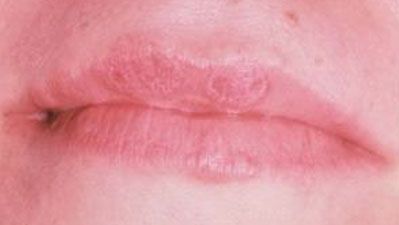- Clinical Technology
- Adult Immunization
- Hepatology
- Pediatric Immunization
- Screening
- Psychiatry
- Allergy
- Women's Health
- Cardiology
- Pediatrics
- Dermatology
- Endocrinology
- Pain Management
- Gastroenterology
- Infectious Disease
- Obesity Medicine
- Rheumatology
- Nephrology
- Neurology
- Pulmonology
Young Woman With Subtle Discoloration of Her Lips

A 27-year-old woman presents with a subtle discoloration of the lips.
The lesions began following sun exposure and have been present for 1 month. There is no history of similar lesions. However, the patient reports that she has had recurrent intraoral lesions and intermittent “enlargement” of the right side of her neck. She also reports a periodic lip lesion (plaque) with normal coloration that is associated with itching and episodic fever blisters; these occur with cold symptoms and lip urticaria. She self-prescribes tincture of benzoin and takes prescribed acyclovir (Zovirax) and an antibiotic when these symptoms flare.
Her medical history is unremarkable. She takes oral contraceptives.
Examination reveals a slightly elevated 0.5- to 1-cm lesion with subtle whitened striae that extend to the vermillion border of the maxillary lip and 2 areas localized to the mandibular lip. No other dermal or oral lesions are present.
What disorders would you consider in the differential, and how would you confirm the diagnosis?
The differential diagnosis included:
• Reticular lichen planus
• Psoriasis
• Lupus erythematosus
• Verruciform hyperkeratosis
• Lichenoid drug reaction
Definitive diagnosis requires results of a biopsy for which the patient was referred to an oral medicine specialist. Incisional biopsy revealed irregularly thickened epidermis with liquefaction (hydropic) degeneration of the basal layer of the epidermis, acanthosis, and slight subepidermal inflammation. Immunofluorescence revealed immunoglobulins at the base of the epidermis. The diagnosis was reticular lichen planus (LP).
Lichen Planus: A Closer Look
This mucocutaneous disease has been defined as immunologic, but it may also be related to drugs and hepatic disease. Immunologic studies suggest that it is T cell–mediated with a mixture of CD4 and CD8 lymphocytes that express integrin molecules of the α1 class. The condition involves disturbance of the epithelial basement membrane, and excess fibrinogen is deposited, which can be visualized with direct immunofluoresence in a pattern that distinguishes this condition from others such as lupus. The presence of plasma cells in combination with the above further suggests a lichenoid drug reaction. However, the antigenic agent(s) responsible for the immunologic reaction are unknown.
There is likely a genetic predisposition as well. The glabrous skin, oral mucous membranes, hair, and nails may be involved.
A number of factors can trigger the condition, including emotional stress, drug hypersensitivity, dental treatment, and certain foods.
Boyd and colleagues1 list the numerous types of LP that are based on clinical appearance. These include actinic, annular, linear, and planopilaris, as well as the oral forms of the disease. Oral forms can present as flat lacy white lines (Wickham striae) that define the reticular form subtype; there is also an erythematous form termed “atrophic LP,” and an ulcerative form that may have associated reticular involvement.
Reticular lesions represent the most common subtype of LP and are estimated to occur in approximately 78% of cases. These develop most commonly on the buccal mucosa, cheeks, gingiva, and tongue. Less commonly, they may occur on the lip or palate. Lesions are usually chronic. Women appear to be affected more than men (as in the patient in this case), usually during the 5th and 6th decade. Skin involvement tends to appear at an earlier age.
Reticular LP has not been shown to progress to neoplastic disease, but at least 1 case has been reported in the literature in which oral cancer developed within the borders of this subtype.2
Teaching Points
• Reticular lesions that occur intraorally or on the lip are typically asymptomatic and do not need management
• Dietary, elements (amalgam), or medications that may be causing a hypersensitivity “lichenoid” reaction should be identified and eliminated
• Erythematous lesions can be managed symptomatically
• The use of a topical corticosteroid coupled with an antifungal medication (such as Mycelex [chlortrimazole] 10 mg troche taken orally for 10 to 14 days) can be helpful in severe cases that involve inflammation
References:
References:
1. Boyd AS, Neldner KH. Lichen planus. J Am Acad Dermatol. 1991;25:593-619.
2. Tomb R, El-Hajj H, Nehme E, Haddad A. Verrucous carcinoma of the tongue occurring on lesions of lichen planus. Ann Dermatol Venereol. 2003;130(1 pt 1):55-57. http://www.ncbi.nlm.nih.gov/pubmed/12605160.
For More Information:
• Mayo Clinic. Lichen planus. www.mayoclinic.com/health/lichen-planus/DS00782.
• British Dental Health Foundation. Lichen planus. 2010. www.dentalhealth.org/tell-me-about/topic/mouth.../lichen-planus.
• Silverman S Jr, Eversole LR, Truelove EL, eds. Essentials of Oral Medicine. Hamilton, London: BC Decker Inc; 2001:chap 21.
• Fernández-González F, Vázquez-Ãlvarez R, Reboiras-López D, et al. Histopathological findings in oral lichen planus and their correlation with the clinical manifestations. Med Oral Patol Oral Cir Bucal. 2010;16(5):e641-646. [Epub ahead of print]. http://www.medicinaoral.com/medoralfree01/aop/16983.pdf.
Obesity Linked to Faster Alzheimer Disease Progression in Longitudinal Blood Biomarker Analysis
December 2nd 2025Biomarker trajectories over 5 years in study participants with AD show steeper rises in pTau217, NfL, and amyloid burden among those with obesity, highlighting risk factor relevance.
